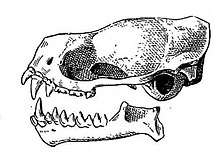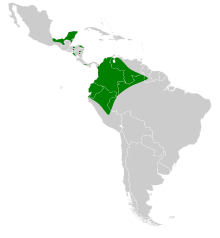Eumops nanus
Eumops nanus is a species of bat found in Central and South America.
| Dwarf bonneted bat | |
|---|---|
 | |
| Scientific classification | |
| Kingdom: | Animalia |
| Phylum: | Chordata |
| Class: | Mammalia |
| Order: | Chiroptera |
| Family: | Molossidae |
| Genus: | Eumops |
| Species: | E. nanus |
| Binomial name | |
| Eumops nanus Miller, 1900 | |
 | |
| Synonyms | |
| |
Taxonomy and etymology
It was first described by American zoologist Gerrit Smith Miller in 1900. Miller initially placed it into the genus Promops. The holotype for the species was collected in Chiriquí Province in Panama; it was sent to Miller by British zoologist Oldfield Thomas. Thomas had received the specimen from HJ Watson, who was the owner of extensive plantations in Panama.[2][3][4] When Miller described a new genus of bat in 1906, Eumops, he placed Promops nanus in the new genus, renaming it Eumops nanus.[5] Its taxonomy has been revised several times, however, with some authors considering it a subspecies of the dwarf bonneted bat.[6] E. nanus was consistently maintained as a subspecies of the dwarf bonneted bat from 1932 until 2007, when Eger et al. recommended that it should be elevated to a species once more.[7]
Its species name nanus is from Latin meaning "dwarf." Miller stated that the species reminded him of a miniature Wagner's bonneted bat.[4]
Description
It is the smallest member of its genus, weighing 6–14 g (0.21–0.49 oz).[8] Miller characterized it as "essentially a miniature of Promops glaucinus."[4] Its forearm is approximately 37–49 mm (1.5–1.9 in) long. Its fur is reddish-brown or dark brown.[8] Its lips are wrinkled. The ears are large and rounded,[8] extending slightly over the forehead with their inner edges touching each other.[4] Its tragus is large and rounded.[8] Its calcar has a pronounced keel.[4] Its tail extends beyond the edge of the uropatagium. Its dental formula is 1.1.2.32.1.2.3 for a total of 30 teeth.[8]
Biology
It is nocturnal, roosting in sheltered places during the day. The holotype was collected under the roof of a house where it was roosting.[4] It is also known to roost in tree cavities.[7] It is insectivorous, consuming moths, beetles, true bugs, and other insects.[1][8] It will forage for prey over bodies of water. In one population in Mexico, late June is the most popular time for parturition. The female nurses the young, called a pup, for 6–8 weeks.[1]
Range and habitat
Its range extends from southern Mexico to northern Colombia and Venezuela, with documented occurrence in Belize, Colombia, Guyana, Honduras, Mexico, Nicaragua, Panama, Peru, and Venezuela.[1] Its occurs in areas of tropical thorn forests, tropical humid forests, and forest edge habitat.[7]
Conservation
It is currently evaluated as least concern by the IUCN—its lowest conservation priority. It meets the criteria for this designation because it has a large range, it occurs in several protected areas, and its population is unlikely to be declining at a rapid rate. Nonetheless, it is a rarely-encountered species.[1]
References
- Solari, S. (2017). "Eumops nanus". The IUCN Red List of Threatened Species. 2017: e.T87994060A87994063. doi:10.2305/IUCN.UK.2017-2.RLTS.T87994060A87994063.en.
- Beolens, Bo; Watkins, Michael; Grayson, Michael (2009). The Eponym Dictionary of Mammals. Baltimore: The Johns Hopkins University Press. p. 440. ISBN 978-0-8018-9304-9. OCLC 270129903.
- Goldman, Edward Alphonso (1920). Mammals of Panama. Washington D.C.: Smithsonian Institution. p. 16.
- Smith Miller, Gerrit. "LXII A new free-tailed bat from Central America". The Annals and Magazine of Natural History: Including Zoology, Botany, and Geology. 7. 6. pp. 470–471.
- Smith Miller, Gerrit (1906). "Twelve new genera of bats". Proceedings of the Biological Society of Washington. 19: 85.
- Sanborn, C. C. (1932). "The bats of the genus Eumops". Journal of Mammalogy. 13 (4): 347–357. doi:10.2307/1374140. JSTOR 1374140.
- Eger, J. L. (2007). "Family Molossidae P. Gervais, 1856". In Gardner, A.L. (ed.). Mammals of South America. Volume 1. Marsupials, xenarthrans, shrews, and bats. Chicago: The University Chicago Press. pp. 410–414. ISBN 978-0801884948.
- Ceballos, G. (2014). Mammals of Mexico. Baltimore. Johns Hopkins University Press. pp. 762–763. ISBN 978-1421408798.
